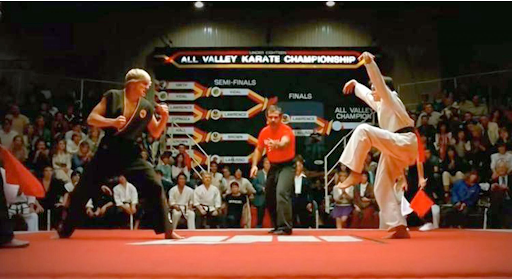Image Attribution: “The Karate Kid, Assignment 4 Part A” by Carlein Kay is licensed under CC0. (See interactive map)
The last action film I watched was The Karate Kid (1984), and while it is now an older action film it is still a classic Hollywood action film at its core. After its initial release in 1984, it made over $91 million worldwide with its PG rated underdog story (“Box Office Mojo,” n.d.). Depicting several scenes of physical violence between the main character Daniel and his bullies, the film shows him eventually overcoming them through a refined and controlled form of violence, karate. The violence is common but is never overly glorified or dramatized for the sake of being impactful, it is tasteful in its implementation.
During the climax of the movie, Daniel and Johnny are fighting in the championship match, shown in landscape orientation to encompass both characters fully. The referee stands in the middle as the dividing line between the two sides and the audience in the background further emphasizes this by being separated into two stands on either side. The board displaying the results also lends to the viewers understanding of the scene by showing the list taper towards Daniel, showing how much he has to overcome. Finally, the two main characters are dressed in their respective colors from throughout the movie, black for Johnny and white for Daniel. Using the common motif of black representing bad and white representing good, the scene reinforces the tone of the movie.
The whole scene is done with very little musical score, focusing instead on the characters words and the sounds of the fight itself to amplify its impact. The camera is stationary, cutting to different people to show their reactions to the match but not moving within those shots. This allows the viewer to focus on what is happening, the control and fluidity of the movement taking place. The speed of the action is absorbed fully by the audience and not lost due to quick edits and flashy movements, the scene isn’t just visual noise as a substitute for action.
The same year that The Karate Kid was released, two other box office hits dropped that created a huge change in the future of movies: Gremlins (1984) and Indiana Jones and the Temple of Doom (1984). During that summer, the movie critics association was bombarded with complaints and demands to do something about the rising level of violence in films. Researchers found that in a study of films from the 1980’s, 1990’s and 2000’s, the most frequent type of violence was physical violence at 46%. And of the films from the 80’s, 37% depicted violence in some form. Surprisingly, of the PG films 93% of them contained violence, films marketed at children (Coyne et al., 2010, pp. 393-395). A new rating was added to try and solve the issue: PG-13. In between PG and R, PG-13 could show higher levels of violence while still being marketed towards younger audiences under the guise that they would have parental supervision to dictate what was appropriate (Kendrick, 2009, pp.170-171). This all helped contribute to a normalising of violence in film by exposing audiences to it at a younger age, and reinforced that action was a main staple of the entertainment industry.
Works Cited
Coyne, S. M., Callister, M., & Robinson, T. (2010, November 5). Yes, Another Teen Movie. Research Gate. Retrieved from https://www.researchgate.net/publication/232929725_Yes_Another_Teen_Movie.
The Karate Kid. Box Office Mojo. (n.d.). Retrieved from https://www.boxofficemojo.com/title/tt0087538/?ref_=bo_se_r_1.
Kendrick, J. (2009). Hollywood Bloodshed: Violence in 1980s American Cinema. Google Books. Retrieved from https://books.google.ca/books? hl=en&lr=&id=rQy7npn3e78C&oi=fnd&pg=PP1&dq=violence%2Bin%2Bhollywood%2Bfilms&ots=Jw7YOL7mHa&sig=RRVuK3AxuMPfg0mvl4Uy9HrFudk&redir_esc=y#v=onepage&q&f=false.
